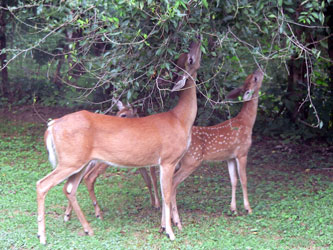Where are the Wild Things? On the Role of Animals in Global Climate Change

Contacts: Diana Kenney, Marine Biological Laboratory
dkenney@mbl.edu, 508-289-7139
Kevin Dennehy, Yale School of Forestry and Environmental Studies
kevin.dennehy@yale.edu, 203-436-4842
WOODS HOLE, Mass.—Only two kinds of animals regularly pop up in climate change research: microorganisms and human beings. Both release carbon dioxide and other heat-trapping gases to the atmosphere as part of their daily routines—microbes by decomposing leaves, plants, and other organic matter, and humans by burning gasoline and fuel oil, as well as forests and fields.
But what about all the other animals—the whales, insects, moose, fish? Do they play a part in emitting carbon to the atmosphere, an abundance of which is altering global climate dynamics?
 White-tailed deer grazing. Image courtesy of Wikimedia.
White-tailed deer grazing. Image courtesy of Wikimedia.Yes, finds a literature review, “Animating the Carbon Cycle,” led by animal ecologist Oswald J. Schmitz at Yale School of Forestry and Environmental Studies, with contributions from scientists at 12 institutions, including Linda Deegan of the MBL Ecosystems Center.
“A lot of the impact these animals have on climate dynamics is indirect,” Deegan says. “For example, if an animal is an herbivore that eats tree leaves, that will change what the tree gives off in carbon dioxide. When you add up these indirect impacts (we call them levers) over the globe, it turns out animals can really change how energy flows in ecosystems, and that effects changes in atmosphere.”
The review gathers several studies that quantify how much carbon is exchanged or stored in an ecosystem—with and without animals. “Some of these are classic examples. What does carbon storage look like when moose are grazing in wetland forest, as opposed to without moose?” Deegan says.
“We hope this article will inspire scientists and managers to include animals when thinking of local and regional carbon budgets,” says Peter Raymond, a former postdoctoral scientist at the MBL Ecosystems Center who is now a professor of ecosystem ecology at the Yale School of Forestry and Environmental Studies.
According to the authors, a more proper assessment of animal controls on ecosystems could provide insight into management schemes that could help mitigate climate change.
The paper issued from a conference, "Managing Species for Regulating the Carbon Cycle," hosted by the Yale Climate and Energy Institute in 2012. More information from the Yale School of Forestry and Environmental Studies is here.
Citation:
Schmitz OJ, et al (2013) Animating the Carbon Cycle. Ecosystems: doi:10.1007/s10021-013-9715-7.